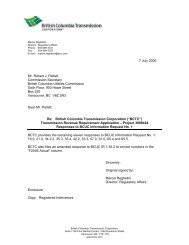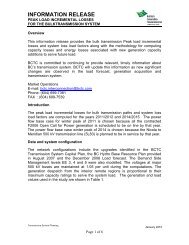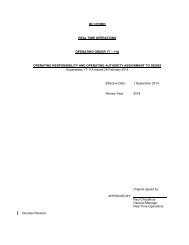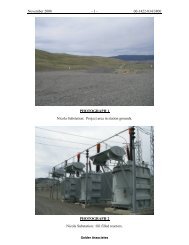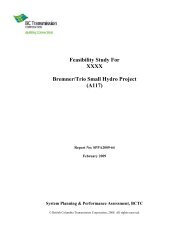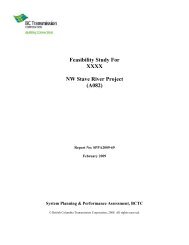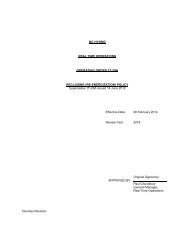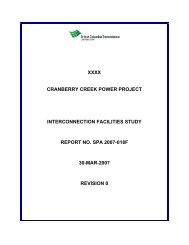Emergency Manual Load Shedding and Peak Load Reduction ...
Emergency Manual Load Shedding and Peak Load Reduction ...
Emergency Manual Load Shedding and Peak Load Reduction ...
Create successful ePaper yourself
Turn your PDF publications into a flip-book with our unique Google optimized e-Paper software.
BC HYDROREAL TIME OPERATIONSOPERATING ORDER 6T – 29EMERGENCY MANUAL LOAD SHEDDING <strong>and</strong> PEAK LOAD REDUCTION PROCEDURESSupersedes 6T-29 issued 10 June 2014Effective Date: 02 July 2014Review Year: 2015Original signed by:APPROVED BY: ___________________Paul ChoudhuryGeneral Manager,Real Time OperationsDenotes Revision
1.0 GENERALOO 6T-29Effective Date: 02 July 2014Page 2 of 13Certain system conditions require BC Hydro to shed customer load rather than risk an uncontrolledfailure of components or cascading outages of the Interconnection. This order specifies proceduresto manually shed customer load after all other remedial steps have taken place. It also specifies <strong>Peak</strong><strong>Load</strong> <strong>Reduction</strong> Procedures <strong>and</strong> guidelines to trip inter-ties to protect BC Hydro system in severeunder frequency situations.Refer to the following BC Hydro operating orders for various load shedding programs which<strong>Emergency</strong> <strong>Manual</strong> <strong>Load</strong> <strong>Shedding</strong> (EMLS) is considered supplemental to or to be used inconjunction with:Note:OO 6T-25: Operation Plan for Capacity <strong>and</strong> Energy Emergencies.OO 6T-28: Automatic Under-Frequency <strong>Load</strong> <strong>Shedding</strong> program.OO 6T-34: Automatic Under-Voltage <strong>Load</strong> <strong>Shedding</strong> program.<strong>Load</strong> shedding in the Ft Nelson Area is implemented automatically due to Alberta IntegratedSystem conditions or directed by AESO. Refer to 3T-FNC-01 <strong>and</strong> 7D-FNN-01.Refer to OO 1T-07B for the authority of System Operators to carry out customer firm load shedding.This order complies with NERC St<strong>and</strong>ard EOP-003 <strong>Load</strong> <strong>Shedding</strong> Plans.2.0 RESPONSIBILITIESThe Transmission Coordinator (TC) is responsible for assessing the need <strong>and</strong> has full authority to: Carry out or direct the applicable Grid Operator (GO) to carry out emergency manual loadshedding as needed. Carry out or direct the applicable Grid Operator (GO) to off-load interties as needed. Direct the applicable <strong>Load</strong> Operator (LO) to begin peak load reduction as needed.The Grid Operator (GO) is responsible for: Executing emergency manual load shedding directives from the TC on an emergency prioritybasis. Executing emergency intertie off-loading directives from the TC on an emergency prioritybasis. Taking any necessary immediate load shedding action to manage any local area risk.Whenever possible, advise the TC prior to acting.The <strong>Load</strong> Operator (LO) is responsible for: Executing for the peak load reduction directives by the TC on a priority basis. Taking any necessary immediate load shedding action to manage any local area risk.Whenever possible, advise the TC prior to acting.The System Control Manager (SCM) is responsible for: Assigning the TC to carry out the monthly EMLS exercise as described in Appendix 6 of thisoperating order. Advising the Manager, Real Time Operations of any required changes to this operating order.The General Manager, Real Time Operations is responsible for: Periodically reviewing the adequacy of the EMLS <strong>and</strong> <strong>Peak</strong> <strong>Load</strong> <strong>Reduction</strong> procedures withapplicable parties. Providing <strong>and</strong> maintaining facilities, supplemental procedures <strong>and</strong> personnel trainingadequate to meet the requirements of this operating order.
3.0 EMERGENCY MANUAL LOAD SHEDDING (EMLS)OO 6T-29Effective Date: 02 July 2014Page 3 of 13EMLS is to be used when the Transmission Coordinator judges that the load must be reduced assoon as possible. EMLS might be necessary for a number of conditions including (but not limited to):Insufficient automatic under-frequency load shedding to arrest frequency decay.Insufficient automatic under-voltage load shedding to prevent voltage collapse.Inability to restore or maintain proper generation-load balance due to severe shortages ofgenerating capacity.Inability to increase frequency by adjusting generation alone to permit synchronizing withother areas.System component overloads which cannot be rectified by other means.For EMLS purpose, the BC Hydro integrated system is segmented into four sub-areas: LowerMainl<strong>and</strong> (LM), Vancouver Isl<strong>and</strong> (VI), Northern Interior (NI), <strong>and</strong> Southern Interior (SI). For eacharea, EMLS will be done in three approximately equal blocks (1, 2, <strong>and</strong> 3) with Block 1 being the firstshed. The total shedding of blocks 1, 2 <strong>and</strong> 3 shall equal one half of the estimated peak load for thatarea. Appendix 1- 4 list all load components to be shed with each block in each area.If practical, shedding should be spread over the system with all areas participating proportionately, butthe TC may order the shedding for specific areas of the system when there is a regional generation<strong>and</strong> load imbalance.The load shedding requirement will generally be recognized <strong>and</strong> load shedding ordered by the TC.But in the event an area is isl<strong>and</strong>ed, the GO / LO responsible for the isl<strong>and</strong>ed area shall shed load asnecessary to maintain frequency. As a minimum, the TC, GO or LO will take action to avoidsustained operation below 57.9 HZ in order to avoid serious problems for customers orBC Hydro equipment.Using supervisory control provided by BC Hydro Energy Management System (EMS), the operatorshall be capable of shedding all three blocks in an area in less than five minutes. Appendix 5describes the EMS displays to be used for EMLS. The permission to operate devices needed to shedload has been assigned to the TC in addition to the applicable GO <strong>and</strong>/or LO. The TC does notmonitor alarms associated with these devices.A poke point to the EMLS screens can be found on each grid sector overview. Additionally, theTransmission Coordinator Overview has a poke point to the EMLS.System voltage shall be closely monitored <strong>and</strong> adjusted during load shedding. <strong>Manual</strong> load sheddingshould continue until frequency is stabilized <strong>and</strong> line <strong>and</strong> equipment loading is within their capability. Ifresidential circuits are shed for more than 30 minutes, the TC or LO should use peak loadreduction procedure, if possible, to enable restoration of these residential circuits.The terminology used by the Transmission Coordinator to order <strong>Emergency</strong> <strong>Manual</strong> <strong>Load</strong><strong>Shedding</strong>, if necessary, will be:"This is an emergency. Shed <strong>Emergency</strong> <strong>Manual</strong> <strong>Shedding</strong> Block(s) _ _ _ _ _ _for the _ _ _ _ _ _ _ _ (LM / VI / NI / SI) area immediately.”All verbal communication involving directives to shed load will utilize formal three-part(repeat-back) communication procedures, using English as the working language.
4.0 PEAK LOAD REDUCTIONOO 6T-29Effective Date: 02 July 2014Page 4 of 13Refer to OO 6T-25 OPERATION PLAN FOR CAPACITY AND ENERGY EMERGENCIES for moredetails.During the onset of an Energy <strong>Emergency</strong>, <strong>Peak</strong> <strong>Load</strong> <strong>Reduction</strong> can help avoiding widespreademergency load shedding. A requirement for peak load reduction will generally occur with severalhours warning. PSOSE <strong>and</strong> FortisBC shall, as necessary, initiate Transmission Voltage Customer<strong>Emergency</strong> <strong>Load</strong> Curtailments to reduce the system load.Also note that load shaving by voltage reduction may also be used in the distribution system, ifavailable. This procedure requires activation in the field <strong>and</strong>, therefore, is more suitable for longerterm load reduction.5.0 OPENING OF INTERTIESExternal Balancing Areas that are seriously under generating can pose a threat to the BC Hydrosystem. Interties need to be tripped if the BC Hydro system is exporting, the frequency isbelow 57.9 Hertz 1 <strong>and</strong> is continuing to decline despite efforts to arrest the decay.In such situation, the Transmission Coordinator will direct the appropriate Grid Operators to off-loadany intertie with the US, Alberta, FortisBC or Alcan where the flow of power is out of the BC Hydrosystem.1 57.9 Hz as per “WECC Coordinated Off-Nominal Frequency <strong>Load</strong> <strong>Shedding</strong> <strong>and</strong> RestorationRequirements”6.0 VOLTAGE CONTROL DURING EMERGENCIESVoltage levels must be closely monitored while load is being shed. All reactive resources should beutilized to control voltage. Circuits should be switched out of service as necessary to control if there isan overvoltage condition when the load is dropped. (See OO 7T-22 for Voltage Tolerances) Inaddition to 500 kV lines, the TC will consider cutting out 230 kV cable circuits to reduce VARs.Lower Mainl<strong>and</strong> cables contribute charging VARs as follows:CCTCCT U/GLength(km)CCT O/HLength(km)Total CCTLength (km)% ofCCTU/G% ofCCTO/HCCT CableMVAR(3 ph at242kV)230kV CCTs2L31 1.1 0.0 1.1 100% 0% 9.22L32 8.6 0.0 8.6 100% 0% 67.32L33 8.7 0.0 8.7 100% 0% 78.02L39 3.3 21.0 24.3 14% 86% 26.72L40 3.3 12.4 15.8 21% 79% 27.02L45 6.1 0.0 6.1 100% 0% 36.42L50 7.4 24.2 31.6 23% 77% 44.82L51(COK-BND) 9.2 0.0 9.2 100% 0% 74.42L51(HPN-BND) 7.7 0.0 7.7 100% 0% 62.82L53 7.3 0.0 7.3 100% 0% 46.92L55 11.3 0.0 11.3 100% 0% 71.62L56 2.2 32.3 34.5 6% 94% 13.52L62 0.8 12.6 13.4 6% 94% 4.72L64 7.1 8.1 15.2 47% 53% 46.3
OO 6T-29Effective Date: 02 July 2014Page 5 of 137.0 RESTORATION OF SERVICEThe GO <strong>and</strong> LO shall obtain permission from the TC prior to restoring load that was shed manually orautomatically. When the BC Hydro system is tied to BPA, the TC shall notify <strong>and</strong> consult with the <strong>Peak</strong>Reliability (<strong>Peak</strong>RC) Reliability Coordinator (RC) prior to restoring loads shed by under frequencyrelays, unless there is an automatic load restoration scheme in place.Restoration of TVC load affected by <strong>Peak</strong> <strong>Load</strong> <strong>Reduction</strong> is the responsibility of PSOSE <strong>and</strong>FortisBC, in consultation with BC Hydro RTO.8.0 REVISION HISTORY (This order is also posted on BC Hydro’s External website)Revised By Revision Date Summary of RevisionTMN 4 September 2009 New Operating Order combining 6T-29A, 6T-29B, 6T-29C,6T-29D <strong>and</strong> 6T-29E.DSM 17 September 2009 Revised LM, NI <strong>and</strong> SI appendices.CAP 09 September 2010 BCTC changed to BC Hydro.DSM 01 October 2010 Appendix 3 – EMLS Block 3 - updated.MPP 21 September 2011 Annual Review Performed.MPP/MH 09 December 2011 Updated for CYP T3. Additional updates in Appendix 1 <strong>and</strong>2 (EFM shutdown).MPP/LR/HQ 13 December 2011 Updated Lower Mainl<strong>and</strong> Block 3, Southern Interior Block 3,remove EFM from Vancouver Isl<strong>and</strong> Blocks <strong>and</strong> minorupdates.MPP 05 September 2012 Annual Review Performed.MPP 19 July 2013 Annual Review Performed.MPP 10 June 2014 Annual Review Performed.MPP 03 July 2014 Updates to Appendix 1, Section 2.0; Appendix 3, Section3.0; Section 1.0; Appendix 4, Section 1.0
Appendix 1OO 6T-29Effective Date: 02 July 2014Page 6 of 13EMLS – Lower Mainl<strong>and</strong> Area1.0 EMERGENCY MANUAL SHEDDING BLOCKS<strong>Manual</strong> load shedding may require up to 50% of the area load to be shed in 3 blocks within 5 minutes.The shedding described in the table in Section 2 is in order of priority within each block.If under frequency load shedding has occurred, some of the loads may already have been shed. Bold<strong>and</strong> underlined stations <strong>and</strong>/or their loads are part of the automatic under-frequency load sheddingscheme <strong>and</strong> might have been tripped should this auto shedding scheme have operated. MW (auto) inthe table summarizes the amount of load shed by automatic under frequency load shedding.Voltage should be monitored frequently while load is being shed. At the direction of the TC, circuitsshould be cut out as necessary to control the voltage.Once load shedding complete, switching should commence to restore station service to affectedstations.2.0 EMERGENCY MANUAL LOAD SHEDDING PROCEDURE<strong>Shedding</strong> should be carried out using the EMLS_OV screen as shown in Appendix 5 (Figure 1). Thereal time loading on each element to be shed is shown on the screen. Follow the steps in sequentialorder as listed in these tables to shed each block:EMLS Block 1at CYP openat WLT openat ALZ openat BND openDevice Affected Stations MW(man)MW(auto)60CB5, 60CB9HSB, LBY 25 060CB13 (T2, 60L89)60CB6, 60CB7 (open onefeed to CAP, GLR, HCT, JLN,JRI, NOR, NVR, SWP, VDK)60CB2, 60CB3 (T1)NXC, SWP, JRI, VDK, 350 13560CB5, 60CB6 (N.O.) DCV, NVR, ERW, NOR,60CB14 (T2)JLN, CAP, GLR, HCT60CB9 (T3)60CB7, 60CB1CHK, SMW, TMO, ALZ 203 5060CB6 (T2)60CB11, 60CB360CB4 (T3)25CB4,25CB5, 25CB6(T4/T1)12CB1, 12CB2 (N.O.), BND 131 012CB3, 12CB4 (T1)12CB5, 12CB6 (N.O.),12CB7, 12CB8 (T2)Total Block #1 709 185
EMLS Block 2at KI1 openat KI2 openOO 6T-29Effective Date: 02 July 2014Page 7 of 13Device Affected Stations MW(man)MW(auto)60CB10, 60CB15 (60L31)60CB1, 60CB20 (60l32)2CB4, 2CB5 (2L64)KI1, LF1,SEA,234 8860CB3, 60CB4 (T1)RIM, YVR,RSR, GDK,60CB6, 60CB7 (T2, 60L43) UNS,60CB9, 60CB10 (T3)UNY(60L46/38)at MAN open 2CB1, 2CB2 (2L55) CSN, SPG 236 0at MAN open 2CB4, 2CB5 (2L53)MAN 182 932CB3, 2CB6 (2L56)at SPG open2CB1, 2CB6 (2L44)Total Block #2: 652 181EMLS Block 3at MUR openat CSQ openDevice Affected Stations MW(man)MW(auto)2CB1, 2CB9 (2L50)496 1302CB3, 2CB4 (2L31)2CB2 (T1)2CB5, (T2)2CB6, 2CB7 (T3)2CB1 (2L20)CSQ, DGR, MUR(Vancouver downtownload)at NEL openat COK open12CB3, 12CB35 (T3)12CB34, 12CB12, 12CB2(T2)12CB1 (T1)25CB41, 25CB42 (T4)25CB43, 25CB44 (T5)25CB32, 25CB34 (T3)NEL (distribution load) 190 135COK (distribution load) 180 176Total Block #3: 866 441ALL LM BLOCKS TOTAL 2227 807
Appendix 2OO 6T-29Effective Date: 02 July 2014Page 8 of 13EMLS – Vancouver Isl<strong>and</strong> Area1.0 EMERGENCY MANUAL SHEDDING BLOCKS<strong>Manual</strong> load shedding may require up to 50% of the area load to be shed in 3 blocks within 5 minutes.The shedding described in the table in Section 2 is in order of priority within each block.If under frequency load shedding has occurred, some of the following loads may have already beenshed.Voltages should be monitored frequently while load is being shed. At the direction of the TC, circuitsshould be cut out as necessary to control the voltage.At the pulp mills, the thermal mechanical pulping (TMP) load is shed. PAL is 30 MW <strong>and</strong> CFT is 20MW in block “A”. PAL “B” is the 25 kV residential load.Once load shedding complete, switching should commence to restore station service to affectedstations.EMLSBlock<strong>Load</strong> or StationApproximateTotal MaximumBlock MW1 GTP-A PAL-A CFT-A 120 MW2 GTP-B PVO NFD HSY-A CLD-A 292 MW3 PAL-B HSY-B HSY-C ESQ-A 304MWTOTAL716 MW2.0 EMERGENCY MANUAL LOAD SHEDDING PROCEDUREThe manual load shedding should be performed from the VI <strong>Manual</strong> <strong>Load</strong> <strong>Shedding</strong> screen asshown in Appendix 5 (Figure 2). It is based on the same load shed matrix used by the VI AutomaticUnder-Voltage <strong>Load</strong> <strong>Shedding</strong> scheme. The VI total actual real time load is displayed on this screen atthe bottom. The VI load change (shed) can be calculated by comparing the VI load display readingbefore <strong>and</strong> after the load shedding.The load shedding screen has 12 non-EMLS blocks <strong>and</strong> 3 EMLS blocks. The automatic (AUVLS)scheme sheds loads displayed in the non-EMLS blocks 1 to 8. Non-EMLS blocks 9 to 12 are used bythe VI Grid Operator to shed load for local system requirements. The blocks are identified by theyellow color border. Each block can be tripped by a single push button that would send trip signal toappropriate breakers at the load locations.
Appendix 3OO 6T-29Effective Date: 02 July 2014Page 9 of 13EMLS – Northern Interior Area1.0 EMERGENCY MANUAL SHEDDING BLOCKS<strong>Manual</strong> load shedding may require up to 50% of the area load to be shed in 3 blocks within 5 minutes.The shedding described in the table is in order of priority within each block.If under frequency load shedding has occurred, some of the loads may already have been shed.Voltage should be monitored frequently while load is being shed. At the direction of the TC, circuitsshould be cut out as necessary to control the voltage.Once load shedding complete, switching should commence to restore station service to affectedstations.EMLSBlock1 CRDStation Device AffectedStations/CircuitsWSN60CB3, 18, 11, 13(Check CRD transfer bus)60CB2, 3CRD60L338 (BCM,HCR, FMC- 50%) *MW<strong>Load</strong>SCK 60CB6, 7 60L310 60RUP 60CB10, 15 60L392 16* Advise FMC to shed all loadafter EMLS is completedSub Total 2362 BLW 2CB2, 6 2L307 105MFE 1CB1, 6 1L366, 368 5GLN 1CB2, 3 1L384 23TKW 1CB9, 11 1L396 47Sub Total 1801603 RBF 25CB11, 13 RBF (25KV <strong>Load</strong>) 30FHS 25CB1, 25CB2 FHS 20BVY 60CB1, 3, 9, 11 60L354 (CHF) 26BVY (25 kV load) 24KDS 2CB1, 2CB3 2L319 (MML) +702L320 (KMI)Sub Total 170TOTAL 5862.0 EMERGENCY MANUAL LOAD SHEDDING PROCEDURE<strong>Shedding</strong> should be carried out using the EMLS OV screen as shown in Appendix 5 (Figure 1). Thereal time loading on each element to be shed is shown on the screen. Follow the steps in sequentialorder as listed in the above table to shed each block:
Appendix 4OO 6T-29Effective Date: 02 July 2014Page 10 of 13EMLS – Southern Interior Area1.0 EMERGENCY MANUAL LOAD SHEDDING BLOCKS<strong>Manual</strong> load shedding may require up to 50% of the area load to be shed in 3 blocks within 5 minutes.The shedding described in the table is in order of priority within each block. The SI West area peakload approximately 770 MW <strong>and</strong> the SI East Area peak load is approximately 160 MW.If under frequency load shedding has occurred, some of the loads may already have been shed.Voltage should be monitored frequently while load is being shed. At the direction of the TC, circuitsshould be cut out as necessary to control the voltage.Once load shedding complete, switching should commence to restore station service to affectedstations.EMLSBlockAffected Circuits/Stations Device Approx.MW <strong>Load</strong>1 1L219 - KWD (28 MW) VVW 1CB2, 1CB10 28DUG 1CB6(KWD load may be offset by generation.<strong>Shedding</strong> is only required if KWD is importing)60L288 – EV1 NTL 60CB15 2360L287 – CFE ELK 60CB5 5Total: 562 1L55 - HVC/STL/LLD HLD 1CB3, 1CB4 1001L244 – WBK NIC 1CB15, 1CB16 7560L28460L29860L299 – JOE/SPL/MYECBK 60CB7, 60CB8KBY 60CB4CBK 60CB5, 60CB651Total: 2263 DUG T1, T3 <strong>and</strong> T4 25 kV Feeders DUG 25CB1, 2, 4 & 1107BKL T1 <strong>and</strong> T3 25 kV Feeders BKL 25CB1, 25CB3 66VNT T5, T6 25 kV Feeders VNT 25CB6, 5 & 8 5560L283 - FST/MVLCBK 60CB8, 60CB9 15KBY 60CB3Total: 301TOTAL 5282.0 EMERGENCY MANUAL LOAD SHEDDING PROCEDURE<strong>Shedding</strong> should be carried out using the EMLS OV screen as shown in Appendix 5 (Figure 1). Thereal time loading on each element to be shed is shown on the screen. Follow the steps in sequentialorder as listed in the above table to shed each block.
OO 6T-29Effective Date: 02 July 2014Page 11 of 13Appendix 5EMLS Screen Displays in EMSFigure 1: EMLS Overview Display (EMLS_OV, SCADA)
Figure 2: VI <strong>Manual</strong> <strong>Load</strong> <strong>Shedding</strong> (LOADSHED_VI, SCADA)OO 6T-29Effective Date: 02 July 2014Page 12 of 13
OO 6T-29Effective Date: 02 July 2014Page 13 of 13Appendix 6EMLS Monthly ExerciseIn order to increase <strong>and</strong> maintain readiness for an emergency condition in which an emergency manual loadshedding routine (as per OO 6T-29) is required, a monthly simulation exercise of the <strong>Emergency</strong> <strong>Manual</strong> <strong>Load</strong><strong>Shedding</strong> is required.The simulation will include the selection of the appropriate circuit breakers for tripping <strong>and</strong> allowance for thetime required for the actual trip execution.The Transmission Coordinator shall lead the exercise. He/she may choose to carry out the entire exercise ordelegate any portion of the exercise to appropriate Grid Operator(s) by issuing manual load sheddingdirectives.Please record the time (minutes, seconds) required for completion of the simulated shedding of each loadblock.RequestTime Area InitialsTime forBlock 1Time forBlock 2Time forBlock 3Report TimeLMVINISITransmission Coordinator: ___________________Date performed: _________________System Control Manager: _____________________This exercise is to be completed by the third Sunday of each month.Return completed form to: Asher Steed






